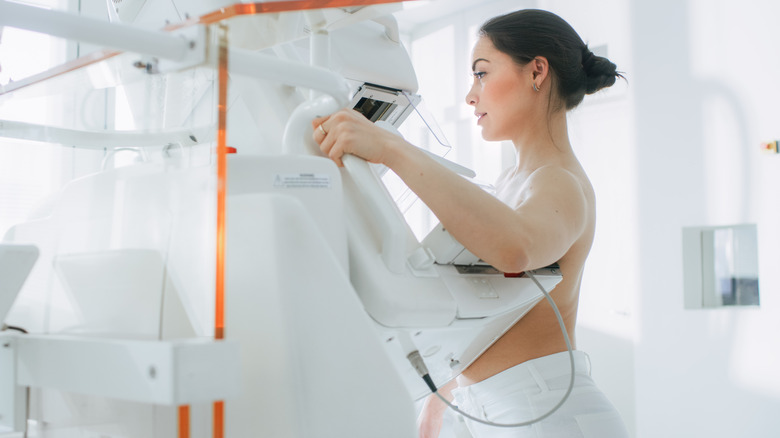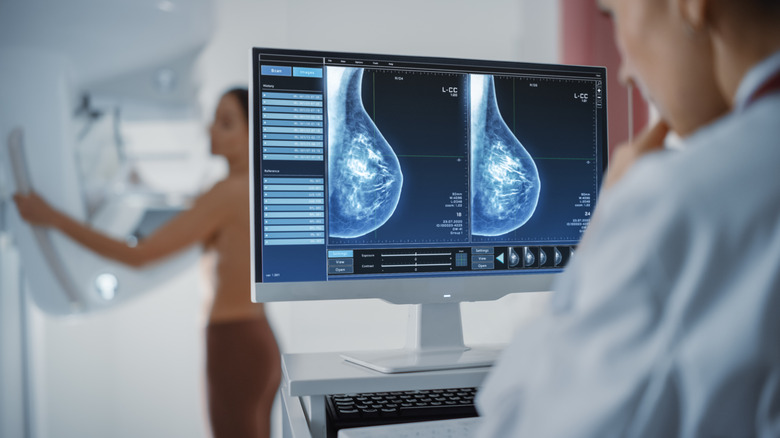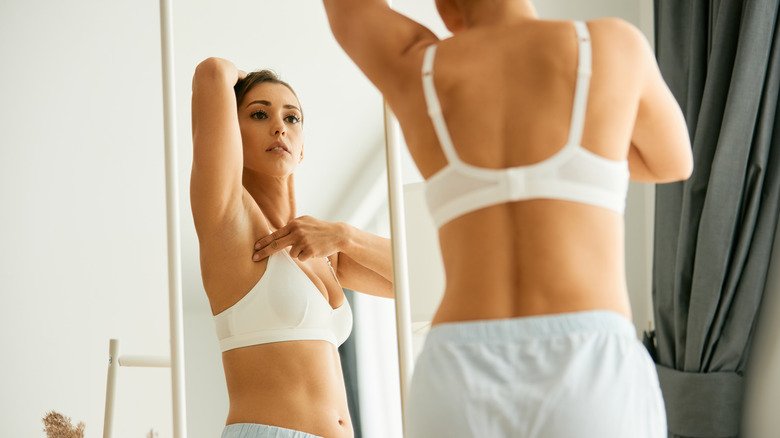Nearly 40% Of People Revealed That This Is How Often They Get Mammograms
October: the perfect month for tricks, treats, and Pumpkin Spice Lattes. But the spooky autumn month signifies more than falling leaves. October also marks the beginning of breast cancer awareness month: a month to raise awareness for Breast cancer, amplify the voices and experiences of those who are currently diagnosed and remember those we've lost to breast cancer.
Breast cancer doesn't discriminate — according to WebMD, celebrities like Julia Louis-Dreyfus, Rita Wilson, Christina Applegate, and Sheryl Crow have all openly discussed their past breast cancer diagnosis. Singer and actress Olivia Newton-John was first diagnosed with breast cancer back in 1992, and became a vocal advocate for breast cancer awareness and treatment, per The New York Times. Sadly, the "Grease" star passed away on Monday morning at the age of 73.
According to Breast Cancer, "1 in 8 U.S. women will develop invasive breast cancer over the course of her lifetime." If identified early on, breast cancer can be treated, and in many cases, eradicated completely. One of the best ways to identify early signs of breast cancer is to get a mammogram: The CDC reports that a screening mammogram consists of an x-ray from two angles, looking for any abnormalities in your breast tissue. But how often do you actually need to get a mammogram? Do you wait until you notice something abnormal, or make frequent visits to be preventative? The List was determined to find out, conducting a survey asking 573 people, "How often do you get a mammogram?"
How often should you be visiting the doctor for a mammogram?
The National Cancer Institute reports that breast cancer is the most common form of cancer, but early detection can drastically increase the chances of successful cancer identification and eradication, with many breast cancer survivors living long, healthy lives past their diagnosis. Mammograms are essential to early detection, but how often should you actually receive one?
According to The List's survey, 39.97% of people have never received a mammogram. About 30.19% reported that they get a mammogram once a year, while another 12.22% said they visit their doctor every two years for a mammogram. 9.25% of voters receive mammograms every three years, while another 8.38% admitted to only receiving one every four or more years.
According to the American Cancer Society, there is a recommended amount of times you should receive a mammogram: doctors encourage women to receive their first mammograms once they turn 40. Annual mammograms are recommended once a woman turns 45, and can switch to every two years after they turn 55. Women under the age of 40 do not need annual mammograms unless they notice something abnormal in their breasts.
How to give yourself a breast exam
What begins as a small lump in the breast can become life threatening if not caught early on — even if you have not reached the age of recommended annual mammograms, it's important to learn how to identify symptoms of breast cancer. One of the best ways to identify breast abnormalities is through self-examinations. According to the National Library of Medicine, 25% of cancer survivors detected their cancer symptoms via self-examination.
The Mayo Clinic provides an easy set of instructions for breast exams at home: first, examine your breast in the mirror, looking for things like inverted nipples or large dimples where there once were none or changes to the size and shape. Raise your arms for a thorough inspection, checking for any noticeable differences in your breasts. Then move on to a physical examination: apply pressure to all areas of your breast using your fingers, looking for a hard lump or any drastic differences from one breast to the other.
Experts suggest lying down and taking your time to become familiar with your body, so you can identify any changes the next time you perform a self-examination. It's important to remember not to panic right away if you notice a change. Most of the time, breast changes and lumps happen naturally and are no cause for concern. Contact a medical professional if you find anything out of the ordinary while giving yourself a breast exam.


